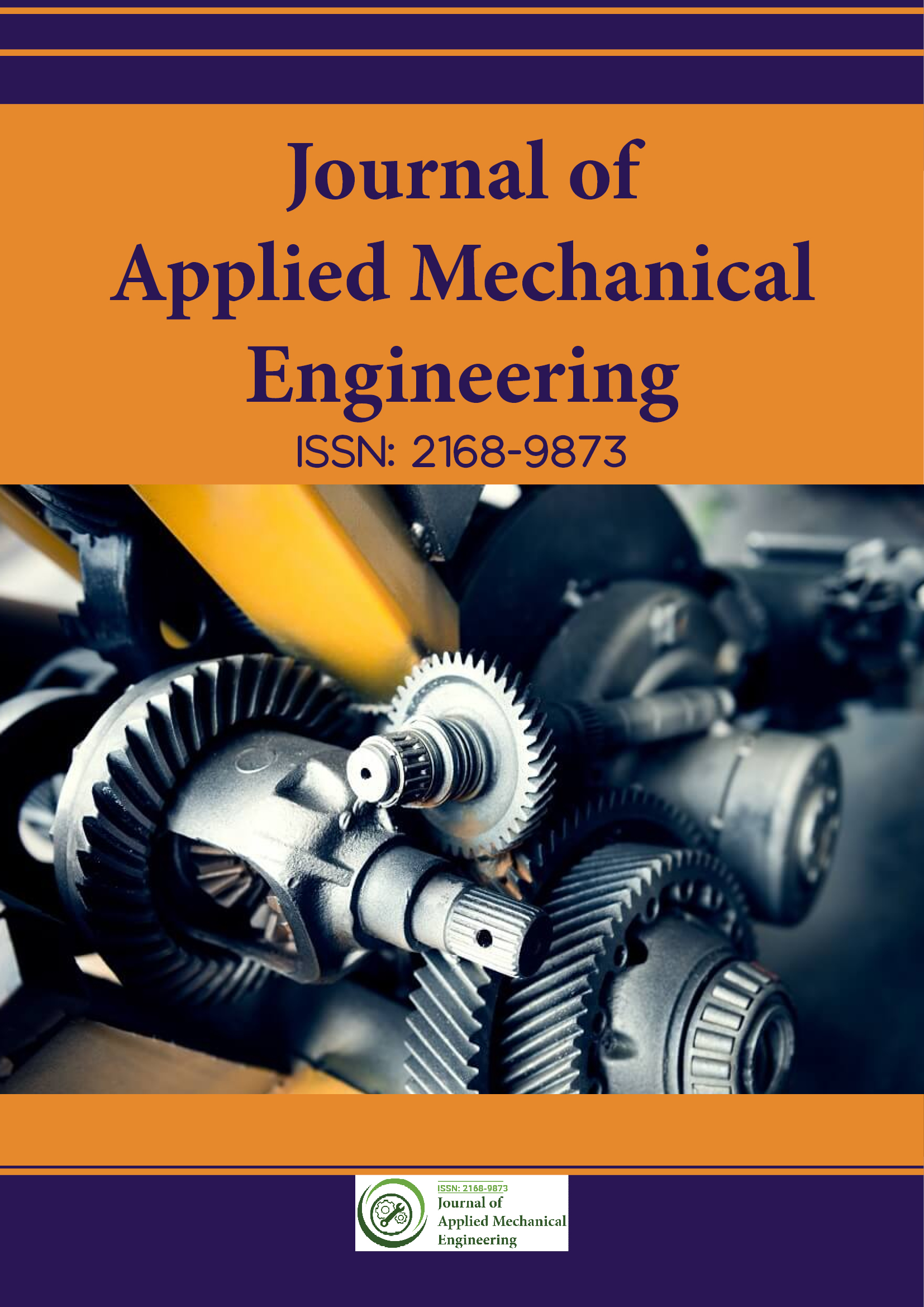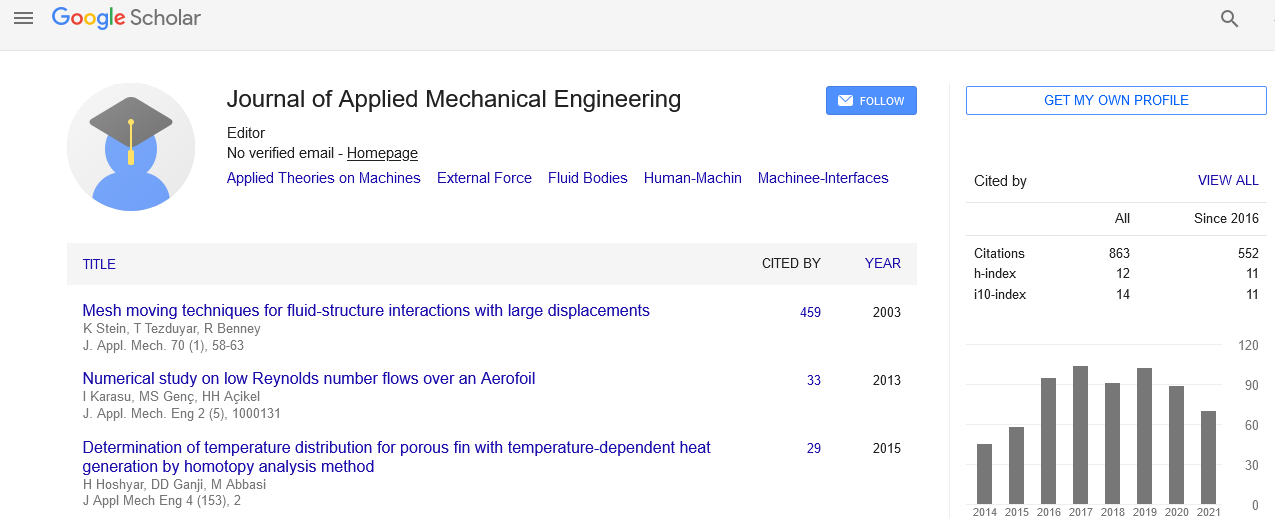Indexed In
- Genamics JournalSeek
- JournalTOCs
- CiteFactor
- RefSeek
- Hamdard University
- EBSCO A-Z
- OCLC- WorldCat
- Publons
- Google Scholar
Useful Links
Share This Page
Journal Flyer

Open Access Journals
- Agri and Aquaculture
- Biochemistry
- Bioinformatics & Systems Biology
- Business & Management
- Chemistry
- Clinical Sciences
- Engineering
- Food & Nutrition
- General Science
- Genetics & Molecular Biology
- Immunology & Microbiology
- Medical Sciences
- Neuroscience & Psychology
- Nursing & Health Care
- Pharmaceutical Sciences
Perspective - (2025) Volume 14, Issue 1
Automation in Mechanical Engineering: Revolutionizing Efficiency and Precision
Yujie Fan*Received: 14-Nov-2023, Manuscript No. JAME-23-23909; Editor assigned: 17-Nov-2023, Pre QC No. JAME-23-23909 (PQ); Reviewed: 01-Dec-2023, QC No. JAME-23-23909; Revised: 09-Jan-2025, Manuscript No. JAME-23-23909 (R); Published: 16-Jan-2025, DOI: 10.35248/2168-9873.25.14.527
Description
Automation has emerged as a transformative force in mechanical engineering, reshaping the landscape of manufacturing, design and operations. From robotic assembly lines to smart systems that optimize efficiency, automation has become a cornerstone of the industry. This article delves into the principles, applications, challenges and future trends of automation in mechanical engineering. Automation in mechanical engineering is rooted in the concept of using technology to perform tasks with minimal human intervention. The integration of sensors, actuators, and control systems enables machines and processes to operate autonomously, enhancing efficiency, precision, and productivity. Automation is particularly relevant in the context of industry 4.0, where the fusion of digital technologies with traditional manufacturing processes is driving a new era of smart manufacturing.
Sensors are significant parts of automated systems, collecting data on various parameters such as temperature, pressure, position and velocity. Control systems, powered by algorithms and feedback mechanisms, interpret this data and make real-time decisions to adjust the operation of machines or processes. The synergy between sensors and control systems forms the backbone of automation. Actuators are devices that execute the actions determined by control systems. In the realm of automation, robotics serves as a prominent example of actuator-driven systems. Industrial robots, guided by sophisticated control algorithms, can perform a wide range of tasks, including assembly, welding and material handling with speed and precision.
Applications of automation
Manufacturing and assembly: Automation has revolutionized manufacturing by streamlining production processes. Automated assembly lines, equipped with robotic arms, can efficiently produce complex products with consistent quality. The automotive industry, for example, relies heavily on automation for tasks such as welding, painting and assembly.
CNC machining: Computer Numerical Control (CNC) machining represents a form of automation that has transformed precision manufacturing. CNC machines use pre-programmed instructions to control the movement of cutting tools, resulting in highly accurate and repeatable machining processes. This level of precision is crucial in industries such as aerospace and medical device manufacturing.
Smart factories: The concept of smart factories integrates automation with data exchange, enabling real-time communication between machines, systems and humans. This interconnectedness enhances monitoring, control and decision-making, leading to adaptive and responsive manufacturing processes. Smart factories are a key component of industry 4.0 initiatives.
Material handling and logistics: Automation plays a pivotal role in material handling and logistics, where conveyor systems, robotic palletizers and Automated Guided Vehicles (AGVs) streamline the movement of materials within facilities. These systems optimize efficiency, reduce errors, and enhance overall supply chain management.
Challenges of automation in mechanical engineering
Implementing automation systems often involves significant upfront costs for equipment, software, and integration. Small and Medium-Sized Enterprises (SMEs) may face challenges in justifying these initial investments, despite the potential longterm benefits. Integrating automation into existing workflows can be complex. Compatibility issues, the need for specialized expertise, and potential disruptions during the transition phase pose challenges for organizations seeking to adopt automation. The introduction of automation may lead to concerns about job displacement. Addressing these concerns requires workforce training to ensure that employees can adapt to new roles and responsibilities in automated environments. Automated systems require regular maintenance to ensure optimal performance. Unplanned downtime due to e quipment failures or software issues can disrupt operations and impact productivity. Effective maintenance strategies are essential to minimize these risks.
Future trends and innovations
Collaborative robots, or cobots, represent a shift towards more interactive and flexible automation. Unlike traditional industrial robots, cobots are designed to work alongside human operators, enhancing teamwork and adaptability in manufacturing environments. The integration of Artificial Intelligence (AI) and machine learning is poised to elevate automation to new heights. These technologies enable systems to learn from data, make predictions, and continuously optimize processes. In mechanical engineering, AI can enhance predictive maintenance, quality control and production scheduling. Digital twin technology involves creating virtual replicas of physical systems or products. In the context of automation, digital twins enable real-time monitoring and analysis, offering insights into performance, efficiency and potential issues. This technology enhances decision-making and facilitates predictive maintenance. Edge computing involves processing data closer to the source rather than relying solely on centralized cloud servers. In automation, edge computing can enhance real-time decision-making and reduce latency, making it particularly relevant for applications that require rapid responses, such as robotics and control systems.
Conclusion
Automation has emerged as a driving force in the evolution of mechanical engineering, reshaping the way products are manufactured, processes are optimized and industries operate. The integration of advanced technologies, such as robotics, AI and digital twin systems, is propelling the industry towards unprecedented levels of efficiency, precision and adaptability. While challenges such as initial costs and workforce adaptation must be addressed, the long-term benefits of automation in terms of productivity, quality and innovation are undeniable. As the field continues to embrace new trends and innovations, automation will remain a key enabler of progress, empowering mechanical engineers to push the boundaries of what is achievable in the dynamic and ever-evolving world of technology and manufacturing.
Citation: Fan Y (2025) Automation in Mechanical Engineering: Revolutionizing Efficiency and Precision. J Appl Mech Eng. 14:527.
Copyright: © 2025 Fan Y. This is an open-access article distributed under the terms of the Creative Commons Attribution License, which permits unrestricted use, distribution, and reproduction in any medium, provided the original author and source are credited.

